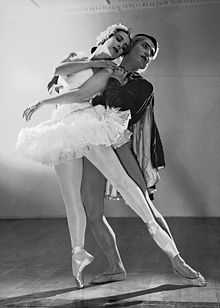Rolf de Maré
Rolf de Maré (May 9, 1888 – April 28, 1964), sometimes called Rolf de Mare, was a Swedish art collector and leader of the Ballets Suédois in Paris in 1920–1925. In 1933 he founded the world's first museum for dance in Paris.
Biography
Rolf de Maré was born in Stockholm in 1888. In 1913 he made friends with post-impressionist painter Nils von Dardel who was not particularly well off, but imaginative and talented, while de Maré was enthusiastic and had money. Together they were a very fruitful duo and in 1920 they created Ballets Suédois at the Théâtre des Champs-Élysées in Paris. In the autumn of 1924 Giorgio de Chirico curated the scenography and costumes for Pirandello's La Giara.
In 1933, Rolf de Maré founded Les Archives internationales de la Danse (AID) in Paris — the world's first museum and research institute for dance. The Archive became a famous centre for studies in dance and visitors came from all over the world to see exhibitions or to study in its vast library. The dance center also published its own magazine and books, arranged lecture demonstrations in the building which de Maré had constructed for his dance centre.
After the World War the archives had grown too large for a private person to maintain, de Maré closed his business in Paris and donated parts of the collections — some 6,000 books, engravings and other items, all concerned mainly with Western dance — to the French government which placed them at the museum and library of the Paris Opera. However, the museum declined to accept two substantial elements of de Maré's collection: firstly, material from the Ballets Suédois, and secondly, the fruits of his expedition of exploration to Indonesia in 1936 — the first to have been undertaken with the purpose of documenting dance.
Therefore, the collection from the Swedish Ballet in Paris and the non-European collections were brought by de Maré to Stockholm to form the Dance Museum, which he opened in 1953 in the basement of the Royal Swedish Opera in Stockholm. On his death he made the Dance Museum the sole heir to his fortune, and this enabled the museum to make further acquisitions.
After dissolving the Ballets Suedois in 1925, de Maré made no attempt to revive its works. The various, concrete collectibles de Maré amassed and that exist today as the bedrock of Stockholm's Dance Museum, illuminate our picture of him as archivist and art collector, all the while they question his role as a connoisseur of a theater based on the art of dancing. Throughout his life, Rolf de Maré was also a distinguished art collector. In the early 1960s, he made an important donation of modernist art to the Moderna Museet. Rolf de Maré died of a stroke in Barcelona in 1964.
References
- Archives of the Dance: The Dance Museum, Stockholm, in Dance Research: The Journal of the Society for Dance Research, Vol. 4, No. 2, 1986.
- At the Vanishing Point: Images of Dance in Archives and on Stage, by Erik Näslund, at the International Association of Libraries and Museums of the Performing Arts : 18th International Congress, Stockholm 3–7 September 1990.
External links
- The Dance Museum in Stockholm Official site
| Wikimedia Commons has media related to Rolf de Maré. |
|
| ||||||||||||||||||||||||||||||||||||
